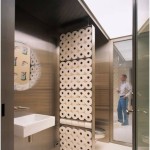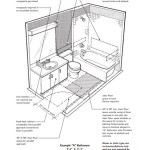Venting Bathroom Fan Through the Roof: A Comprehensive Guide
Proper ventilation is crucial for maintaining a healthy and comfortable indoor environment, especially in moisture-prone areas like bathrooms. While traditional venting systems often utilize walls or attics, venting a bathroom fan through the roof directly offers several advantages, including improved airflow, reduced condensation, and potentially enhanced aesthetics. However, this approach requires careful planning and execution to ensure optimal performance and prevent potential issues.
Benefits of Venting a Bathroom Fan Through the Roof
Venting a bathroom fan through the roof offers several benefits compared to traditional wall or attic venting methods:
- Improved Airflow: Direct roof venting eliminates potential obstructions caused by walls and attics, allowing for a more efficient and direct path for exhaust air to escape. This leads to faster and more effective removal of moisture and odors.
- Reduced Condensation: By removing moisture-laden air directly to the exterior, roof venting minimizes the risk of condensation build-up within the attic or walls. This helps prevent mold and mildew growth, safeguarding the structural integrity of the home.
- Enhanced Aesthetics: Roof venting can be aesthetically pleasing, especially when using a discreet vent cover that blends seamlessly with the roofline. It avoids the need for visible vent pipes running through the walls or attic spaces.
- Potential for Energy Savings: In some cases, roof venting can contribute to energy savings by reducing the load on the HVAC system. By effectively removing moisture, roof venting can help create a more balanced and comfortable indoor environment, potentially reducing the need for excessive heating or cooling.
Choosing the Right Roof Vent
Selecting the appropriate roof vent is crucial for optimal performance and longevity. Several factors influence this decision:
- Fan Size and Power Rating: The size and power rating of the bathroom fan determine the volume of air it can exhaust. Choose a vent that matches the fan's output for efficient and effective ventilation.
- Vent Material: Roof vents are typically made from durable materials such as PVC, ABS, or metal. Choose a vent that is weatherproof and resistant to corrosion.
- Roofing Material: Consider the type of roofing material used on your home. Some vents are specifically designed for certain roofing materials, ensuring a secure and aesthetically pleasing installation.
- Ventilation Area: The vent's free area, or the size of the opening, determines the amount of air that can pass through it. Select a vent with a sufficient ventilation area to accommodate the fan's output.
- Vent Design: Consider design features such as louvers, screens, and weather caps to maximize airflow while preventing the entry of rain, insects, or debris.
Installation Considerations
Successful roof venting requires careful planning and execution to ensure optimal performance. Consider the following aspects:
- Roof Slope: The roof's slope plays a crucial role in determining the vent's location and installation method. Ensure the vent is positioned to allow for adequate drainage and prevent water from accumulating around the base.
- Flashing and Sealing: Proper flashing and sealing around the vent are essential to prevent water infiltration and leaks. Use high-quality flashing materials and techniques that comply with local building codes.
- Vent Placement: Position the vent in a location that avoids obstructions such as trees, chimneys, or other structures that may hinder airflow or create turbulence.
- Access for Maintenance: Consider accessibility for future maintenance and cleaning. If possible, position the vent in a location that allows for easy access to the fan and vent components.
- Code Compliance: Consult local building codes and regulations regarding roof venting requirements. Ensure the vent type, location, and installation meet or exceed local standards.
Vent a bathroom fan through the roof can be a practical and effective solution for improving ventilation and enhancing the overall comfort of your home. However, it's important to carefully consider the benefits, choose the right vent, and ensure proper installation to prevent potential issues.

Installing A Bathroom Fan Fine Homebuilding

Bathroom Exhaust Fan Can Vent Out Through The Wall Or Up Roof Building America Solution Center

Blog

How To Vent A Bath Fan Through The Roof This Old House

Venting A Bath Fan In Cold Climate Fine Homebuilding

Bathroom Vent Piping To Near Exterior Inspecting Hvac Systems Internachi Forum

Adding A Bathroom Fan Fine Homebuilding

Bath Vent Fan Exhaust Placement Under Gable Overhang Or Thru Shallow Pitched Roof Greenbuildingadvisor

Venting A Bathroom Through Sips Fine Homebuilding

Why Does My Bathroom Ceiling Fan Drip Foothills Roofing Calgary
Related Posts







